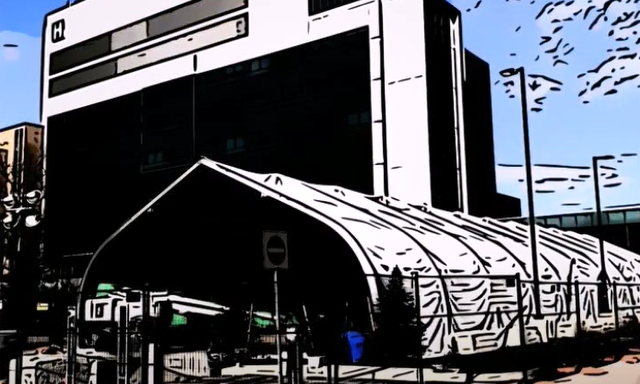We are CodeNext and we wanted to take a minute to tell you a story
The CodeNext team was excited to start a new year. Now in our 3rd year of business, we had just welcomed our 7th team member and moved into our new office! The energy was high, we were excited for a new space to grow as a team and our vision for 2020 was crystal clear.
And then….. Exactly 2 weeks after moving into our new office, schools, cities and businesses were shut down, we were suddenly all working from home (with our partners and kids around!) and instead of sitting at our new conference table, we were waving hello to each other during daily video calls.
Life rapidly transformed. The news was filled with uncertainty about our hospitals ability to support their communities.
Then the phone rang. It was late in the afternoon on a Thursday. We were being asked to jump in on a teleconference to discuss the immediate need for designing and constructing a temporary structure to support Joseph Brant Hospital in Burlington. We were uniquely positioned to be part of a dynamic and innovative team to plan, design and implement the first temporary hospital in Ontario. Surrounded with other brilliant stakeholders and committed professionals, CodeNext got to work. We were uniquely positioned to be part of a dynamic and innovative team to plan, design and implement the first temporary hospital in Ontario.

What were we up against in terms of design challenges?:
- Well, time was NOT in our favour, but the CodeNext team had to ensure full compliance with the Ontario Building Code and The Ontario Fire Code.
- Ontario Building code is not written to address temporary building structures and we had to come up with a solution that would achieve at least an equivalent level of safety.
- Communication was paramount between the team and The City of Burlington’s Building and Fire Services divisions to ensure we were all on the same page.
- Also we had to have extensive correspondence with Joseph Brant. An understanding of what they needed from a medical perspective was paramount so that we could develop a solution that would enable them to do what they do best. Also we had to have extensive correspondence with Joseph Brant.
With each and every second counting…where did we begin? We started with OBC Section 3.14 and OFC Section 2.9 (which are the sections on tents). But wait…these sections pretty much exempt you from most fire and life safety requirements you would expect in a healthcare facility. We needed more. So, we adopted additional fire and life safety measures to protect the occupants of the facility.
As you can imagine, there were added complexities to consider:
- a direct connection to the main hospital,
- getting power to the structure,
- an open area to provide medical staff the sightlines they need,
- mobility of patients,
- the fire risk with a potentially oxygen enriched environment,
- and the evacuation plan.
Were there challenges? Absolutely! But CodeNext loves a good challenge, and our team got to work, around the clock and one by one came up with innovative solutions to each and every one of these challenges. Frankly, it is what we do best and our team is uniquely positioned to respond with tremendous creativity, agility and technical knowledge.
The result? The first officially approved Temporary Pandemic Response Unit in Ontario that is now able to accommodate 89 patients and staff. Even better – as a result of the teams who worked on this project, Ontario passed emergency legislation to allow the construction of temporary medical facilities. This Order in Council means that our solutions to all the obstacles will set the way for all future construction and renovation of temporary health facilities.
The CodeNext team will continue rolling up our sleeves, and coming up with solutions to obstacles. It was a pleasure to work with so many brilliant collaborators on such an important project. Thank you to all who were part of this initiative and we continue to work with on future structures. We love using our knowledge to keep our communities safe.
Thank you for taking the time to read our story and from all of us here, stay safe.


3 Responses
Great read. Section 3.14 is unique to the Ontario Building Code and does not appear in the National or British Columbia Building Codes, or the Vancouver Building By-law. The requirements in these codes come from Subsection 3.1.6 and are quite onerous, particularly when it comes to spatial separation requirements for tents.
Clause 1.1.1.1.(2)(f) of Division A in the BC Building Code and Vancouver Building By-law do not require temporary buildings to conform to the codes with the permission of the authority having jurisdiction. The Ontario requirements could serve as a guide for an acceptable level of life safety for temporary buildings in these jurisdictions.
Congratulations Gerry to you and your team. Sounds like it was a very challenging but rewarding project.